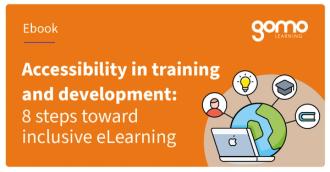Accessible training requires two ingredients: an authoring tool packed with features that accommodate various needs, and instructional designers prepared to use them.
Even with both of these ingredients to hand, there’s a lot to consider if you want your learning content to be successfully experienced by as wide a variety of learners as possible. That’s why we’ve prepared a list of five urgent and impactful features your courses need to include in order to help you hit your accessibility goals.
1) Think about color hues, combinations, and contrasts
When it comes to sight-related disabilities, it’s easy to overlook color blindness—but without factoring it into your eLearning design, you might become the proud owner of a beautifully curated learning program that a large part of your audience just can’t read.
According to the UK’s National Health Service, color vision deficiency affects one in 200 women and one in just 12 men. As such, it’s highly likely that your learner audience includes people who struggle to distinguish between yellows, reds, oranges, greens, and browns (or, more rarely, blues, greens, and yellows).
In an eLearning context, it’s particularly easy to neglect the needs of the color-blind community. After all, instructional designers will be aware that color is linked to better learning outcomes, with academic studies “presuppos[ing]” that color-related methods “allow better memorization of educational material.”
By the same token, however, the importance of color in eLearning provides all the more incentive for L&D teams to make sure the color combinations, hues, and contrasts they use are accessible to people who experience color blindness.
Get tips for boosting your eLearning inclusivity:
4 planning tips for creating culturally-aware global eLearning2) Follow text spacing guidelines
The world of typography is built on quantifiable font sizes and spacing—so it’s no surprise that 2023’s Web Content Accessibility Guidelines (WCAG) draft gets specific about accessible text spacing.
The standards body requires that web content (including eLearning material) should be able to have line spacing set to 1.5 times the font size, while letter spacing should reach 0.12 times the font size.
These might seem like complicated goals to achieve, but an accessible-first authoring tool will allow you to set global themes and styles that automatically apply to every piece of content. While this kind of feature is great for brand consistency, it also has highly useful applications as a means of setting up accessible visual features, from text spacing that meets WCAG requirements to color combinations that work for color-blind individuals.
By letting your authoring tool take care of the nitty-gritty touches that make content truly accessible, your instructional designers can divert their attention toward some of the more complex aspects of eLearning accessibility—including interactions.
Discover more benefits of visual themes with this article:
5 authoring tool features that deliver incredible value3) Swap out your interactions to meet different needs
Accessibility in training courses doesn’t end with how users see or hear content. The best eLearning programs take the form of highly interactive experiences, and with good reason—research suggests that learning outcomes are improved when audiences take a more active role in the learning experience.
However, some interactive learning elements won’t suit every learner’s needs and abilities. A drag-and-drop task, for example, which asks learners to match questions to answers via a computer mouse, won’t be an effective assignment for learners who can’t use a mouse comfortably (or at all).
Good authoring software will provide the tools to navigate varied ability levels. Gomo, for instance, allows authors to set display conditions that can tailor learning content to people with disabilities, ensuring that every learner encounters material that suits their needs.
As with many accessibility considerations, having the tool is only half the battle. It’s down to instructional designers to ensure that the interactions they swap in feel just as engaging and memorable or ‘flavorful’ as the ones they replace.
Read more about interactions:
Using creative interactions to build engaging courses, part 1: locking screens4) Look out for keyboard-accessible navigation
For learners that find pointing devices difficult to use, or can’t use them at all, it’s not enough to swap out mouse-related interactions—you’ll need learning content that can be navigated entirely through a keyboard.
With between four and 10 million Americans suffering from carpal tunnel syndrome alone—not to mention the array of other mobility limitations that can impact computer usage—keyboard navigation is one of the most important accessibility features you can implement.
That’s why it’s essential to use an authoring tool that arranges its visual elements into ordered columns and blocks, allowing users of accessibility devices built around keyboard-based inputs to tab through content without a mouse in sight.
5) Include image captions and alt text
There’s no getting away from images as an essential part of your training programs. Not only do visual aids play a part in making your courses more engaging and memorable, but the presence of pictures can add a touch of character to your content. Without image captions, however, you won’t realize the potential of your eLearning content for every learner.
Unlike video captions, which work best for people experiencing auditory challenges, image captions—also known as alt text—are the perfect way to unlock the value of your pictures for people with visual impairments.
Alt text should be succinct and descriptive, capturing the flavor that a given picture adds to its course while summarizing the subject, setting, or action that the image portrays.
About the author: Simon Waldram
As Product Manager at Gomo, I’m passionate about delivering value at every interaction and to increase sustainable proven value for our customers and business.
I have extensive experience of working within both the commercial and educational sectors, and approach all projects with a strategic mind.
This combination of education and commercial experience has enabled me to stay at the leading edge of emerging technologies to ensure that customers are provided with a framework for success.

